Skipped Stitches Troubleshooting Flow Chart
Step-by-step guide of what to do when you get skipped stitches on your sewing machine
Greetings everybody,
Skipped stitches are among the most common issues sewists encounter with their sewing machines, and it's a topic I've covered extensively in previous articles. In this edition of The Sewing Machine Newsletter, I've distilled that knowledge into a clear, step-by-step troubleshooting guide designed as a simple flow chart.
Each step is numbered, and most steps link to previous articles I’ve written that cover the reason why that step exists in extensive detail. The idea is that if you encounter skipped stitches, then you would start at Step 1 and test the machine to see if Step 1 fixed the problem. If the problem is fixed, then mission accomplished. If not, then you would move sequentially through the other steps until your issue is resolved. My goal is to empower you to troubleshoot effectively at home, potentially saving you a trip to the repair shop. I hope you find this guide both practical and helpful.
—Cale
Skipped Stitches Troubleshooting Flow Chart
1. Insert a fresh needle.
A bent needle— even one that is ever so slightly bent— can negatively affect the machine’s needle-hook clearance and cause skipped stitches. Whenever I experience skipped stitches, the first thing I do is insert a new needle and see if that solves the problem
2. Make sure you are using the correct needle type for the fabric.
Stretch fabric requires a stretch needle, or else we risk skipped stitches. Meanwhile, thicker fabric requires a larger needle, because a small needle can potentially have trouble penetrating thick fabric, leading to needle deflection and skipped stitches.
3. Make sure you are using quality thread.
Whenever someone brings in a machine and has experienced skipped stitches, I also make sure to test it with thread I trust to be good quality, such as Aurifil, Mettler, or Isacord. Poor quality thread may posses certain characteristics (such as undue stiffness or stickiness) that hinder the machine’s ability to create a thread loop. If the thread loop is distorted due to these unwanted thread characteristics, then skipped stitches will likely result.
4. The Pull Test
A snag on the upper thread could cause skipped stitches. Perform the pull test and see if you can feel the upper thread snagging as you pull on it when the presser foot is raised (presser foot raised = zero tension condition).
A common area where the thread snags is the spool cap. A spool cap that is too big or too small can cause thread snags. Make sure your spool cap is slightly larger than the plastic end of the thread spool.
Another reason for thread snags is burrs on the machine cover.
And, yet another reasons for thread snags is compacted lint along the upper thread path. If you are feeling a snag, but don’t see any burrs in the cover and are using the correct spool cap, then raise the presser foot and use compressed air to blow any and all obstructions out from the upper thread path.
5. Check for other obstructions along the thread path
Whether it be the upper thread source (needle thread) or bobbin thread source, the thread must flow freely from the thread source as your sewing machine sews and makes stitches. There are many different points along the thread path where obstructions can occur and prevent the thread from flowing freely. Sometimes, these obstructions can cause skipped stitches.
Needle strikes on the bobbin case may cause skipped stitches.
Needle strikes on the needle plate hole may also cause skipped stitches.
A loosely wound bobbin can also cause skipped stitches.
Adhesive on the needle, hook, or bobbin case can also cause skipped stitches.
6. Check Needle-Hook Timing
Remove the bobbin case and needle plate so that you can get a clear view of hook point as it passes behind the needle. Turn the machine’s hand wheel so that the needle is in the bottommost position. Continue to slowly turn the hand wheel until the hook passes behind the needle. The hook should pass just above the needle eye when the needle has risen a couple of millimeters above its bottommost position. If it is passing underneath the needle eye, or way above the needle eye, then your sewing machine is probably out of time and needs to be taken to a trained technician.
7. Check Needle Hook Clearance
When the hook passes behind the needle, the hook must pass within a specific distance range from the back of the needle in order to catch the thread loop. You don’t want the hook to be so close that it touches the needle, but you don’t want it to be so far away that it passes behind the thread loop instead of passing through.
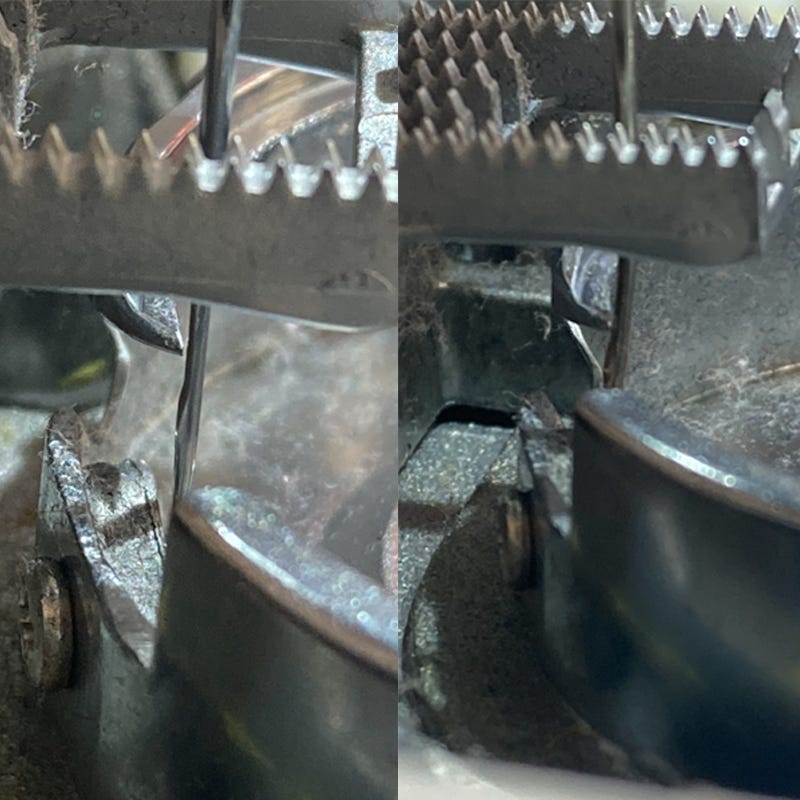
Needle-hook clearance is a critical setting that can cause skipped stitches if too tight or excessive in distance. If you are getting skipped stitches because needle-hook clearance is truly out of whack, a trained sewing machine technician should be able to fix the problem for you.
Thank you for reading!
Sewing machines are intricate tools, and there are indeed additional reasons for skipped stitches beyond what's covered here. However, I've addressed the most common issues sewists typically face, and I sincerely believe this guide will be a valuable resource for anyone troubleshooting skipped stitches.
I'd love to hear your feedback—please share your thoughts in the comments below. Feel free to pass this guide along to your fellow sewing enthusiasts, and don't forget to browse the archive for more sewing machine tips and educational content.
Thank you,
—Cale





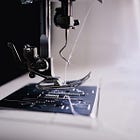
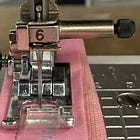



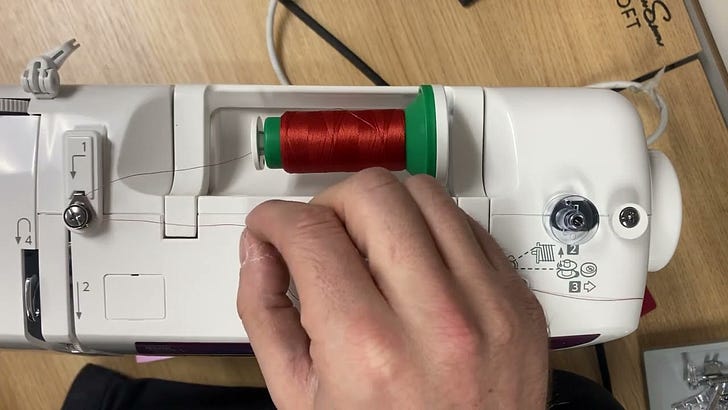
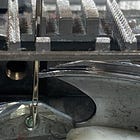
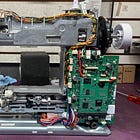
I had a terrible time with skipped stitches on my Featherweight a few years ago. Did the basic checks and fixes; no luck. Discovered the timing was off. Fixed it and learned a lot in the process! Including that it's something I'd never attempt on a more advanced machine. But I can't remember if the adjusted timing fixed the skipping. Something did. I didn't know timing could affect skipping until reading your article. And, oddly, my machine seems to prefer basic C&C thread, probably because of how it is wound. I bought an adaptor for using cross-wound thread but haven't tried it yet because all is good right now and I don't want to mess anything up :)
Thanks Cale. I really enjoy and appreciate your newsletters. I always learn something new or get a refresher on something I already know. Keep it up